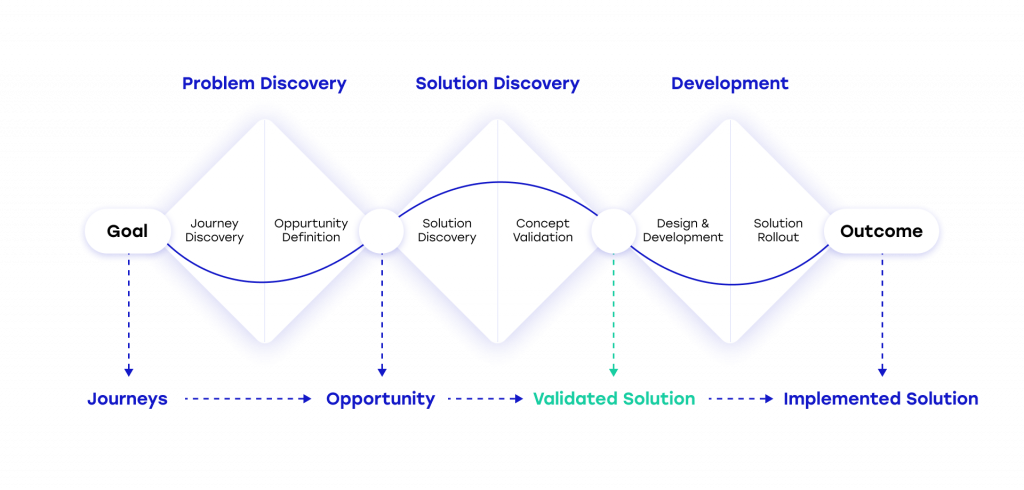Executive summary
Estonia is known for its advanced e-services, but e-state solutions need constant enhancement to maintain the high satisfaction rate of citizens. As the next step in their evolution, the state anticipates transitioning to proactive, event-based e-services for citizens. The goal is to create public services that are easy and convenient to use (for example, utilizing a 1-Click principle for design), employing information already at the disposal of the state.
As one of the first steps on this journey, the Ministry of Economic Affairs and Communications commissioned an analysis of the technical feasibility of a local government service portal for applying for a kindergarten. The project aimed to analyze the feasibility of a service portal used across different municipalities running the kindergarten network and chart the users’ expectations and frustrations to propose suggestions for improving the service for parents.
This case study outlines:
- the methodology Helmes design team applied to the task,
- the various stages of the project,
- and key results, including some surprising findings, which highlight the possibilities of service design and offer valuable insights for organizations planning to launch new services.
Background: Proactive government services as the next step for e-Estonia
The Estonian state anticipates that the next step in the evolution of public services will be transitioning to proactive, event-based government e-state solutions. The goal is to make public services as easy and convenient as possible for an individual using existing information in state registries.
Currently, public services in Estonia are provided at the user’s initiation, often requiring requests to multiple authorities and various applications. In the future, government services could be grouped together and provided to the user in the form of a single smooth service and, when possible, proactively. Receiving services or allowances would be triggered by various life events, such as getting married or giving birth, and would ideally require no more than a single click from the user.
As one of the first steps in the transition towards event-based services, the Ministry of Economic Affairs and Communications commissioned in 2020 an analysis of the technical feasibility of a local government service portal, using the example of the event service “Application for a kindergarten place.” Helmes was selected to carry out the analysis, and we completed the project in the first half of 2021.
The challenge: A service portal for kindergarten applications
The project’s objective was to answer two questions:
- Is it possible to create a joint service portal for local municipalities that differ in population, practices, and resources?
- How to simplify the process of applying for kindergarten places for parents?
Although commissioned by the Ministry, the project was closely tied to local municipalities, represented by The Association of Estonian Cities and Municipalities, responsible for running the kindergartens and managing the applications in practice.
Team and the work process
The Helmes team involved in the project comprised a project manager, analyst, service designer, and architect. We started with a kick-off meeting and laid down the project roadmap and the schedule for regular meetings with the client.
We conducted the work in two stages:
- The discovery/research phase and conceptualizing the solution
- A technical analysis where we created an architectural design for the portal
In the discovery phase, our design team typically seeks to understand the client’s perception of their end users as well as the end users’ view of the service. We seek to identify the gap between these two perceptions, which, more often than not, is there.
We follow design thinking principles in the process, including the triple diamond method; this means first adopting a broad view and gathering as much data as possible, then narrowing the focus to pin down the data relevant to the particular challenge. Then, once again, we broaden our focus to search for possible solutions and narrow it down to pick the most suitable one.

Here’s how it looked in practice.
DISCOVERY PHASE STEP 1. Gathering insights from a working group
As the first step, we held asynchronous seminars with a working group composed of the Ministry of Economic Affairs and Communications representatives, the Association of Estonian Cities and Municipalities, and select municipalities. We asked the working group members to fill in worksheets about the users of the future portal as they envisioned them.
We aimed to identify the prospective users’ demographic profiles, experiences, expectations, and frustrations. The questions covered the users’ generational differences, digital fluency, education and occupation, character, and hobbies.
Based on the responses, we synthesized the main user segments – as pictured by the officials (we later asked Statistics Estonia to analyze how well these matched the actual demographic distribution of parents).
We also sought to identify the user segments currently struggling the most with the application procedure, whose stress could be most relieved by improving the user experience (it turned out to be first-time parents).
As a result of the survey, we formed the initial hypotheses about the prospective users and their problems.
STEP 2. Conducting interviews with parents and officials
We proceeded with in-depth interviews with 23 interviewees. About half of the interviewees were recent parents; the other half were local government employees: officials, kindergarten directors, and teachers.
We paid great attention to composing the sample to reflect the diversity of the municipalities, which differ in their size, practices, and resources, starting with the capital city and neighboring municipalities and ending with small rural municipalities in remote regions.
We conducted remote interviews lasting 1-2 hours with all the respondents, mapping the steps in the user journey, users’ frustrations, and expectations. We included control questions to understand the respondents’ honest opinions and attitudes toward the services provided by municipalities.
By clustering these insights, we could uncover response patterns, which revealed the users’ main pain points and expectations.
STEP 3. Reporting conclusions and suggestions
At the end of the discovery phase, we compiled a report of our conclusions and suggestions for improving the application process.
Our key finding was that the parents saw the application procedure as a minuscule part of a larger process. Their view encompassed a much longer time scale from pregnancy to the child’s enrollment in school. Applying for a kindergarten place was a tiny and relatively unimportant moment on this long journey.
What mattered for the parents were:
- The emotional aspects (for example, concern that they might run out of parental allowance if they don’t get a kindergarten place in time to return to work)
- The transparency of the process (for example, how the places are allocated, if there are available places in the kindergarten of the parent’s choice, what the particular kindergarten’s teaching methodology and personnel are like).
Consequently, we proposed suggestions addressing these two main concerns that would increase the transparency of the process and allow parents to plan their return to work with greater confidence.
We saw that these frustrations could be, to a large extent, solved with the following:
- improved communication, including automated notifications triggered by certain life events
- automatically enrolling the child for kindergarten in their municipality.
In the report, we outlined various versions of the solution with differing levels of complexity.
On the one end of the continuum are simple automated notifications, where parents would receive information about the procedure for applying for kindergarten places upon the birth of the child.
On the other end of the continuum is a fully automated system where algorithms calculate the probable time the child will enter the kindergarten and automatically enroll them in a kindergarten place in their municipality.
According to Statistic Estonia, the probability of a child entering kindergarten in the municipality they were born in is 80 percent. Thus, the fully automated solution would simplify the process for 80 percent of people, while the remaining 20 percent could adjust the choices manually.
STEP 4. Technical analysis
Equipped with these insights and the concept for a future solution, we proceeded to the project’s second phase, where our architect analyzed its technical feasibility (for instance, which existing systems need to exchange information) and suggested a possible architecture for it.
This analysis equipped the Ministry of Economic Affairs and Communications with insights necessary for taking the next steps toward harmonizing and improving the service across municipalities. We divided the steps into four tangible phases, where the first iteration would be the easiest to develop (“the lowest-hanging fruits”).
Every next step will add automation and proactiveness to the service and will be more technically challenging. Hence, the analysis serves as a concrete input for planning and commissioning the development of a joint portal for kindergarten applications.
Benefits of service design when launching new services
Enlisting the help of service designers offers benefits to any organization planning to launch new services or products. By delving deep into user personas and their behavior, organizations can avoid mistaken assumptions that would lead to costly changes if discovered only after launching the service.
Discovering faulty assumptions and correcting the course already in the planning stages shortens the time to market and makes it possible to launch services that offer maximum value to users.
Our goal at the service design team is to create a positive societal impact by designing better services. If you’d like to learn more about service design opportunities, we’d be happy to share our experiences with you.
Get in touch
Get in touch







